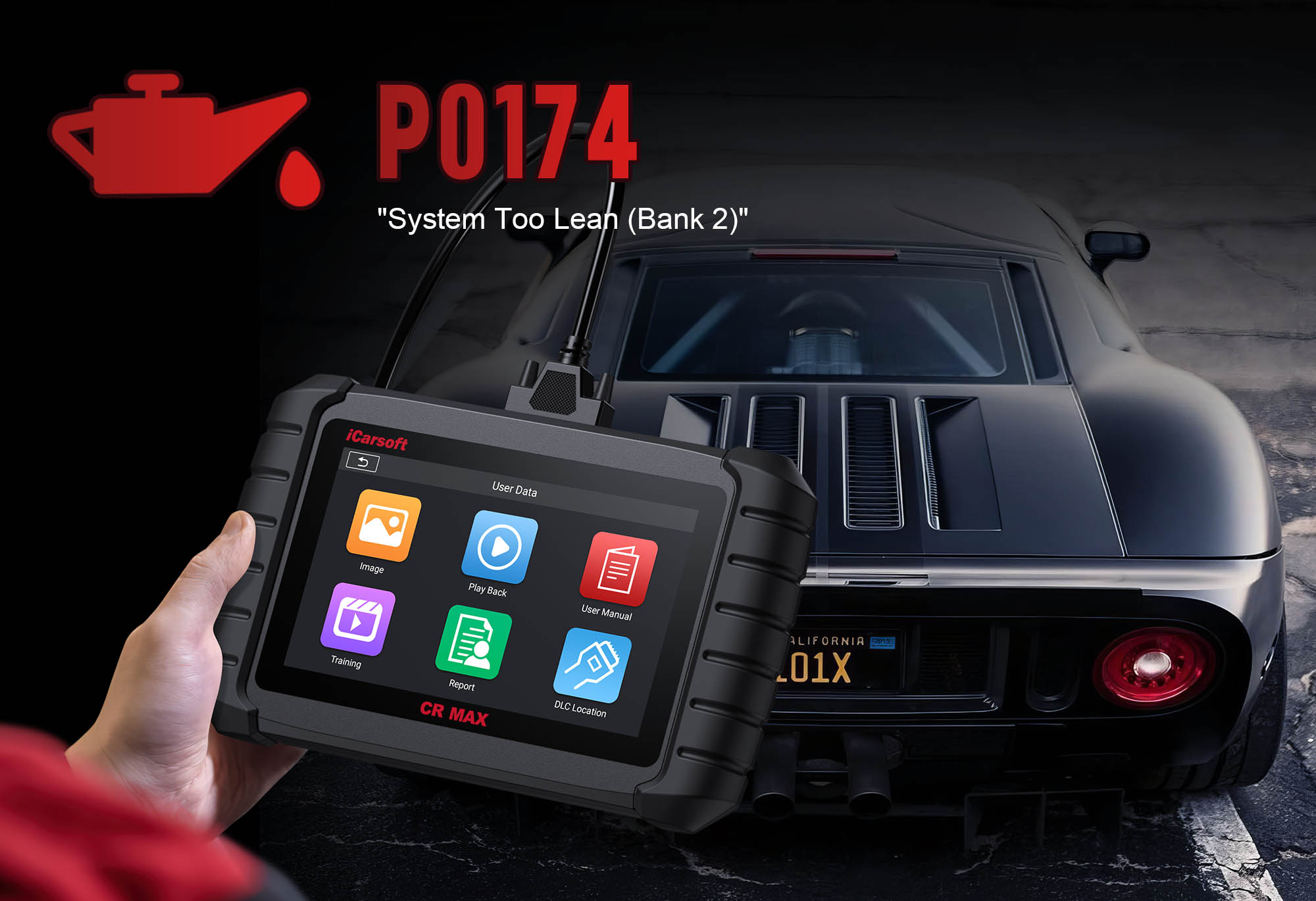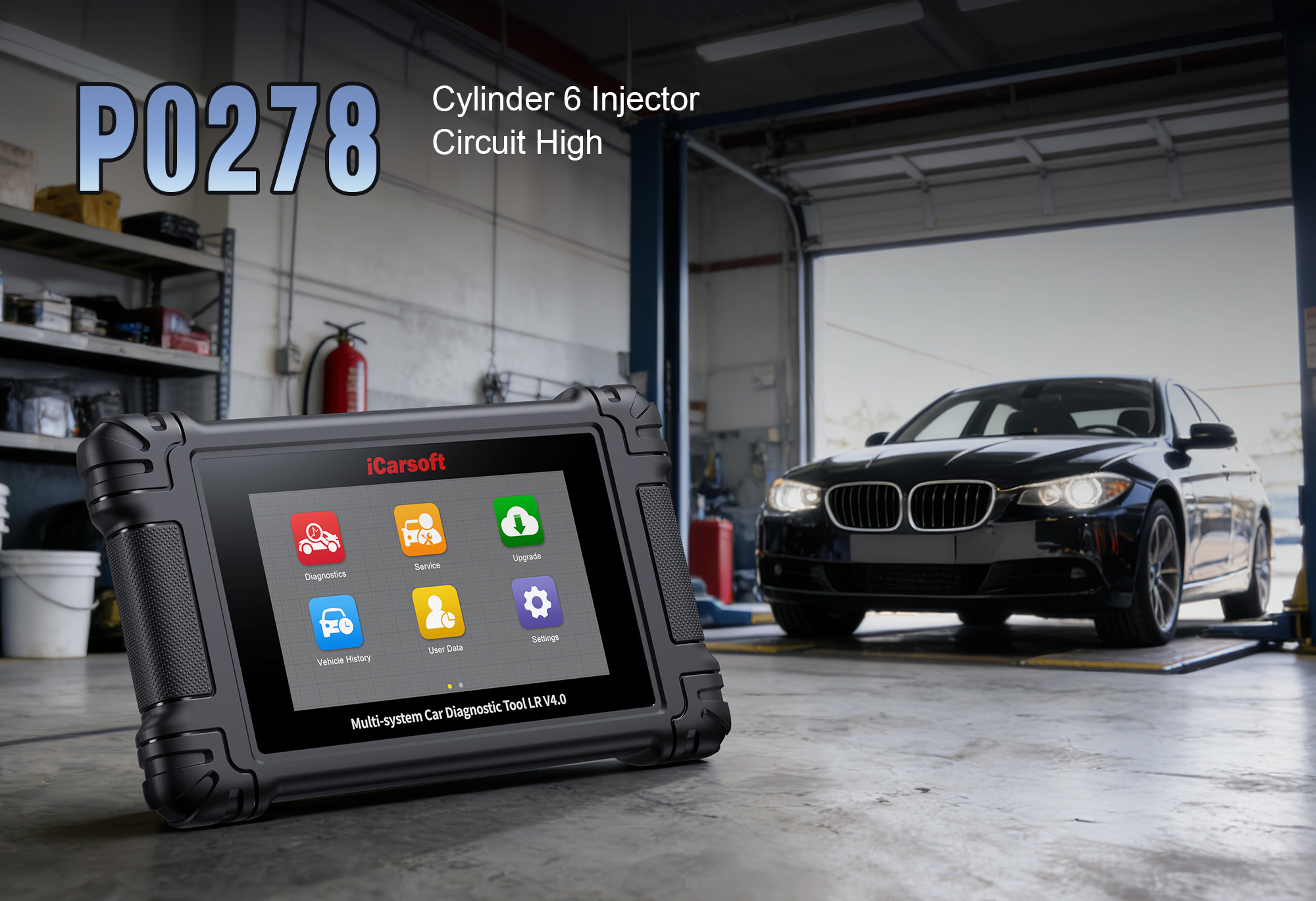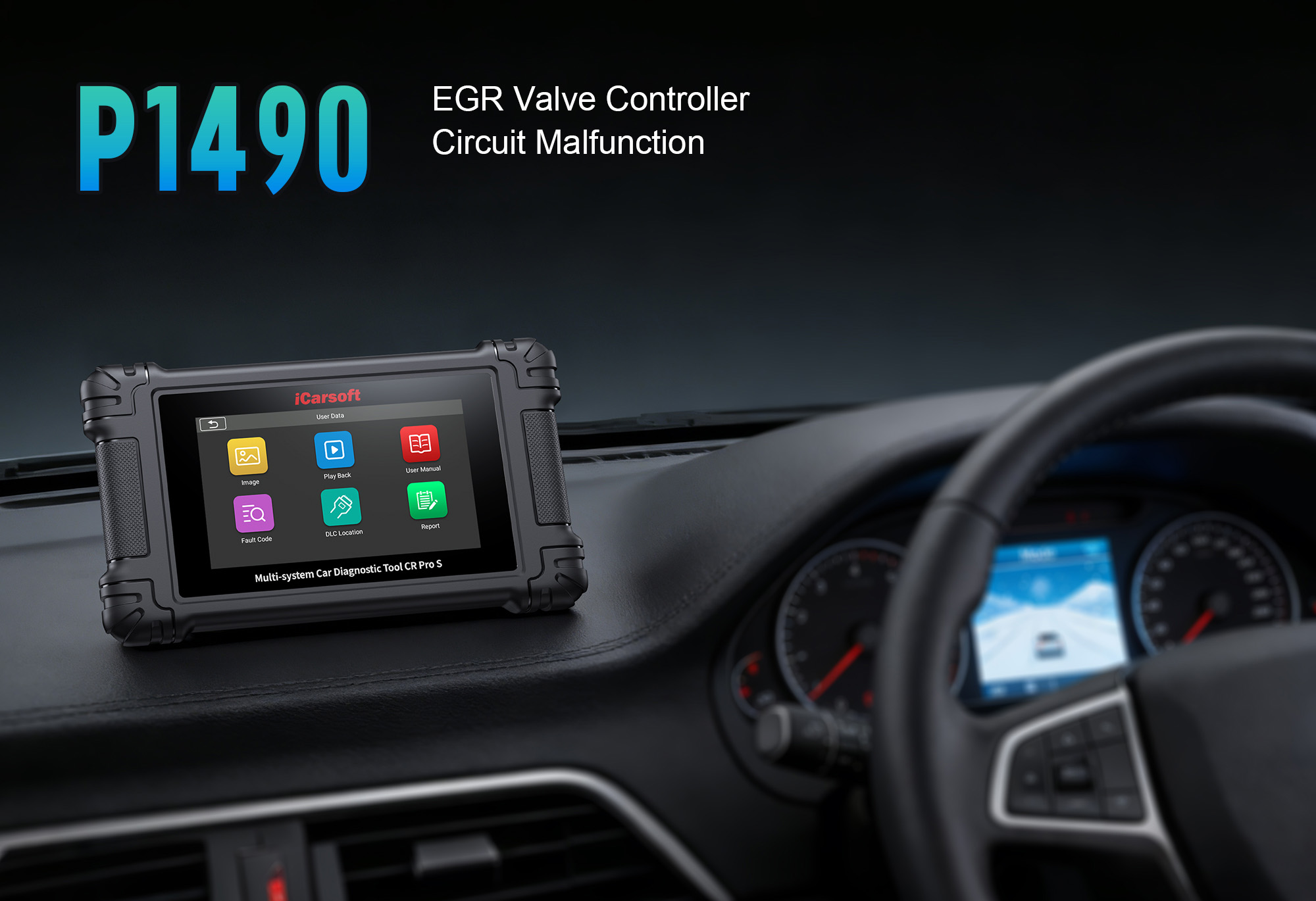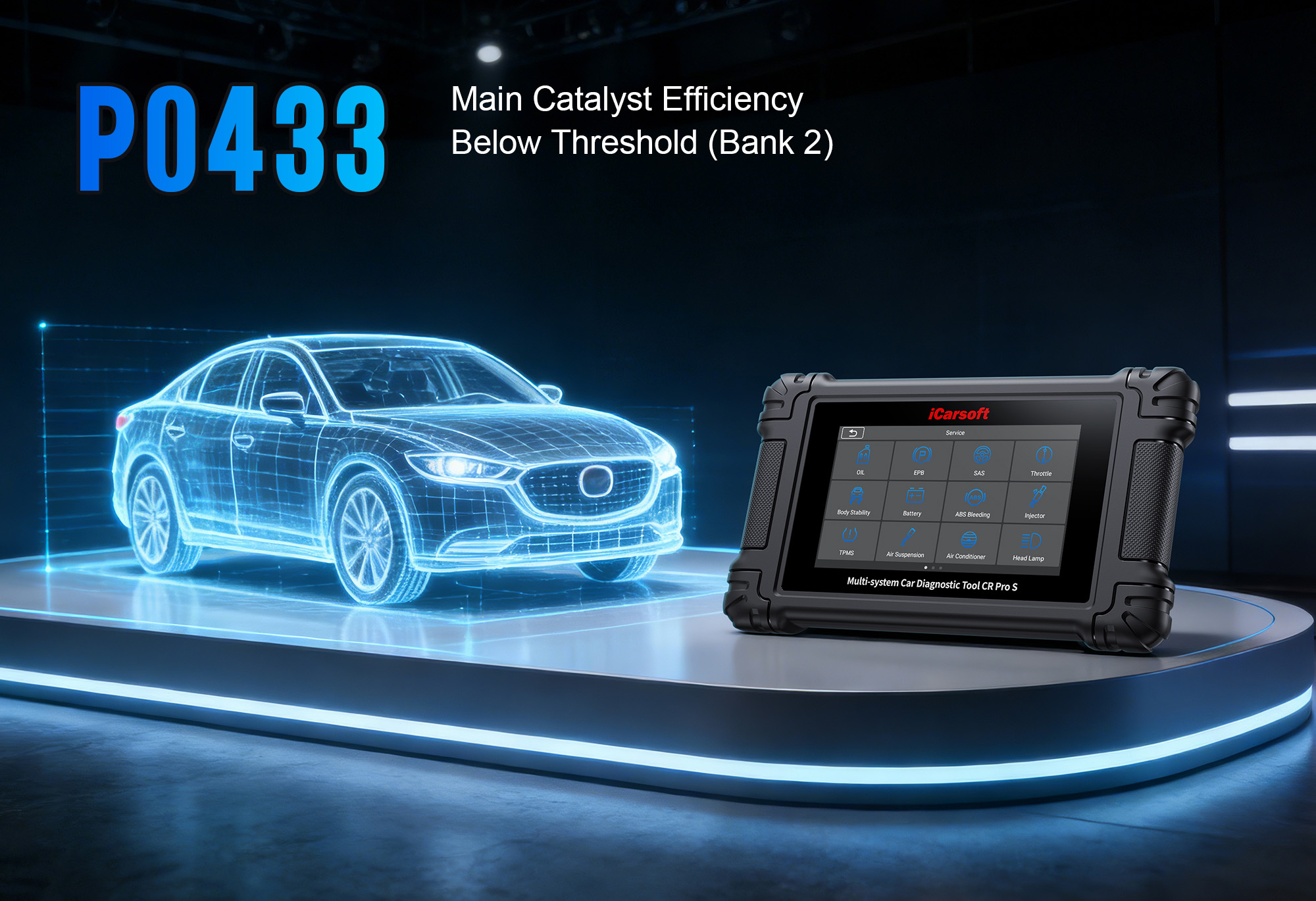P0174 Code: System Too Lean (Bank 2) – What It Means & How to Fix It (iCarsoft CR MAX Guide)
If your check engine light turns on and a diagnostic scan reveals code P0174—"System Too Lean (Bank 2)"—your engine’s air-fuel mixture is out of balance: Cylinder Bank 2 (the side of the engine with the second set of cylinders, e.g., cylinders 4-6 in a V6) is receiving too much air or too little fuel. This imbalance doesn’t just trigger a warning light—it leads to rough idling, reduced power, increased fuel consumption, and even catalytic converter damage over time.
P0174 is a generic OBD-II code, but its root cause is tricky to pinpoint: It could stem from a vacuum leak, dirty MAF sensor, clogged fuel injector, or faulty oxygen sensor. Basic scanners only confirm a "lean condition" but fail to isolate the issue. The iCarsoft CR MAX changes this with advanced data monitoring, cylinder-specific analysis, and targeted component testing—making P0174 diagnosis and repair straightforward. This guide breaks down the process step-by-step.
First: Understand P0174 – What It Means & Why It Happens
Clarify the basics of P0174 to avoid misdiagnosis and unnecessary part replacements:
Key Context: Air-Fuel Mixture Fundamentals
A healthy gasoline engine runs on a 14.7:1 air-to-fuel ratio (stoichiometric ratio)—14.7 parts air to 1 part fuel for complete combustion. A "lean" mixture means there’s excess air relative to fuel (e.g., 16:1), causing incomplete combustion. The Engine Control Module (ECM) detects this via oxygen (O2) sensors and triggers P0174 for Bank 2.
What Is Cylinder Bank 2?
Bank 2’s location varies by engine type—confirm with your vehicle’s specs (or the CR MAX’s Component Location tool):
V6/V8 Engines
Bank 2 is the side opposite the #1 cylinder. Example: Chevy 5.3L V8 (Bank 1 = cylinders 1-3, Bank 2 = cylinders 4-6); Ford 3.5L EcoBoost (Bank 1 = cylinders 1-3, Bank 2 = cylinders 4-6).
Horizontally Opposed Engines (Subaru)
Bank 2 = passenger-side cylinders (Bank 1 = driver-side cylinders). Common in Subaru Outback, WRX, and Forester models.
Inline Engines (4-Cylinder)
Rarely trigger P0174 alone (inline engines have one bank). If P0174 appears, it may be a generic miscode—check for P0171 (Bank 1 lean) instead.
Key Symptoms of P0174
Rough Idle & Hesitation
Engine shakes at idle or hesitates when accelerating—lean mixture causes uneven combustion in Bank 2 cylinders.
Reduced Power
Slower response when pressing the gas pedal—insufficient fuel in Bank 2 limits engine output.
Increased Fuel Consumption
The ECM adds extra fuel to compensate for the lean mix, leading to 1–3 MPG lower efficiency.
Check Engine Light + Related Codes
P0174 often pairs with P0171 ("System Too Lean, Bank 1") if the issue is widespread (e.g., dirty MAF sensor).
Engine Misfires/Stalling (Severe Cases)
Extreme lean conditions (e.g., large vacuum leak) cause misfires or stalling—unsafe for driving.
Common Causes of P0174
Vacuum Leaks (Most Common)
Cracked intake hoses, loose manifold gaskets, or faulty brake booster lines let extra air into Bank 2’s intake—disrupting the air-fuel ratio.
Dirty/Faulty MAF Sensor
A contaminated Mass Air Flow (MAF) sensor underreports incoming air, causing the ECM to send too little fuel to both banks (triggers P0174 + P0171).
Clogged Fuel Injectors (Bank 2)
Restricted injectors on Bank 2 deliver less fuel than needed—isolated lean condition (only P0174).
Faulty O2 Sensor (Bank 2)
A failing upstream O2 sensor (Bank 2 Sensor 1) sends incorrect lean signals to the ECM—even if the mixture is balanced.
Low Fuel Pressure
Weak fuel pump or clogged fuel filter reduces fuel delivery to all injectors—triggers P0174 + P0171.
Air Intake Restrictions
Dirty air filter or blocked intake port limits airflow—but this usually affects both banks (P0174 + P0171).
Why iCarsoft CR MAX Is Perfect for P0174
P0174 requires bank-specific data and system-wide testing—areas where basic scanners fail. The CR MAX excels with these critical features:
CR MAX Features for P0174 Diagnostics
Bank-Specific Data Monitoring
Compares real-time data from Bank 1 and Bank 2 (fuel trim, O2 sensor voltage) to isolate whether the lean condition is Bank 2-only or widespread.
Fuel Trim Analysis
Tracks Short-Term Fuel Trim (STFT) and Long-Term Fuel Trim (LTFT) for Bank 2—lean conditions show LTFT >10% (ECM adding extra fuel to compensate).
MAF Sensor Testing
Measures MAF airflow rate and voltage to confirm if it’s underreporting/overreporting air intake—critical for ruling out system-wide lean issues.
Fuel Pressure Monitoring
Reads fuel rail pressure (on supported vehicles) to rule out low fuel delivery (a common cause of dual-bank lean codes).
Bi-Directional Control
Manually activate Bank 2 fuel injectors and test O2 sensors to verify component functionality—no guesswork.
Vehicle-Specific Specs
Preloaded with factory air-fuel ratios, fuel trim ranges, and Bank 2 component locations for thousands of makes/models (Ford F-150, Toyota Camry, Subaru Outback).
Step-by-Step: Diagnose P0174 with iCarsoft CR MAX
-
1. Connect CR MAX & Confirm P0174
-
Plug the CR MAX into your vehicle’s OBD-II port (under the dashboard) and power it on.
-
Select your vehicle’s make, model, and year—use AutoVIN Recognition for accuracy (ensures correct Bank 2 definitions and sensor specs).
-
Navigate to OBD-II > Fault Codes > Read Codes to confirm P0174. Note related codes:
-
P0171 (Bank 1 lean): Widespread issue (dirty MAF, low fuel pressure).
-
P0121 (throttle position sensor): May disrupt air intake—address first.
-
Tap Code Details to view vehicle-specific triggers (e.g., "2018 Toyota Camry: Bank 2 LTFT >15% for 20 consecutive seconds").
-
2. Analyze Fuel Trim Data (Critical for Lean Conditions)
Fuel trim data is the fastest way to confirm a lean Bank 2 and narrow the cause:
-
Go to Engine > Live Data > Fuel System and select these parameters for both Bank 1 and Bank 2:
-
STFT (Short-Term Fuel Trim): Real-time fuel adjustments (normal range: ±5%).
-
LTFT (Long-Term Fuel Trim): Long-term fuel adjustments (normal range: ±10%).
-
Start the engine and warm it to operating temperature (10–15 minutes—coolant temp >180°F).
-
Compare Bank 1 vs. Bank 2 data to choose your next step:
-
Scenario 1: Bank 2 LTFT >10%, Bank 1 normal: Isolated Bank 2 issue (vacuum leak, clogged injectors)—proceed to Step 3.
-
Scenario 2: Both Banks LTFT >10%: Widespread issue (dirty MAF, low fuel pressure)—proceed to Step 4.
-
Scenario 3: STFT fluctuates wildly: Intermittent vacuum leak or faulty O2 sensor.
-
3. Check for Bank 2-Specific Vacuum Leaks
Vacuum leaks are the #1 cause of isolated Bank 2 lean conditions. The CR MAX streamlines leak detection:
-
Step 1: Visual Inspection: Use the CR MAX’s Component Location tool to find Bank 2’s intake components (intake manifold, hoses, gaskets). Look for:
-
Cracked silicone hoses (common near the throttle body).
-
Loose/broken clamps on intake tubes.
-
Oil residue around manifold gaskets (sign of past leaks).
-
Step 2: CR MAX Vacuum Leak Test:
-
Turn off the engine. Navigate to Special Functions > Intake Tests > Vacuum Leak Detection.
-
Follow on-screen prompts (seal the intake with a smoke machine or pressure test kit—sold separately).
-
The tool monitors Bank 2 vacuum levels:
-
Normal: Stable vacuum (18–22 inHg at idle for gasoline engines).
-
Dropping Vacuum: Leak detected. CR MAX suggests Bank 2-specific leak points (e.g., "Check Bank 2 intake manifold gaskets on Ford 3.5L EcoBoost").
-
Step 3: Fix Leaks: Replace cracked hoses, tighten clamps, or reseal the intake manifold with OEM gasket sealer. Use the CR MAX’s Torque Specs guide for proper bolt tightness.
-
4. Test MAF Sensor & Fuel Pressure (Widespread Lean Issues)
If both banks are lean, focus on system-wide components that affect all cylinders:
-
MAF Sensor Test:
-
Go to Engine > Live Data > Air Intake and select "MAF Airflow Rate" and "MAF Voltage."
-
Start the engine and rev to 2,000 RPM:
-
Airflow rate should increase smoothly (e.g., 10–15 g/s at idle, 40–60 g/s at 2,000 RPM—check CR MAX’s vehicle-specific specs).
-
Voltage should range from 0.5V (idle) to 4.5V (wide-open throttle).
-
Erratic/low readings: Clean the MAF sensor with specialized MAF cleaner (follow CR MAX’s MAF Cleaning Guide). Replace if issues persist.
-
Fuel Pressure Test:
-
Navigate to Engine > Live Data > Fuel System > Fuel Rail Pressure (available on vehicles with fuel pressure sensors).
-
Start the engine: Normal pressure = 30–80 psi (varies by vehicle—check CR MAX’s specs).
-
Low pressure: Faulty fuel pump or clogged fuel filter. Use the CR MAX’s Fuel Pump Activation Test to verify pump functionality (activates the pump with the engine off).
-
5. Test Bank 2 Fuel Injectors & O2 Sensor
If Bank 2 is still lean after fixing leaks/MAF, test its fuel delivery and sensor components:
-
Fuel Injector Test:
-
Go to Special Functions > Fuel System > Injector Activation.
-
Select Bank 2 injectors (e.g., Injectors 4,5,6 on a V6) and activate them one by one.
-
Listen for a consistent "click" (injector opening) and monitor Bank 2 STFT on the CR MAX:
-
No click/STFT doesn’t change: Clogged or faulty injector (replace with OEM parts—use CR MAX’s Part Lookup).
-
O2 Sensor Test:
-
Navigate to Engine > Live Data > Oxygen Sensors > Bank 2 Sensor 1 (upstream sensor—closest to the engine).
-
Monitor voltage: Should fluctuate between 0.1V (lean) and 0.9V (rich) every 1–2 seconds.
-
Flatline voltage (>0.5V or <0.5V): Faulty O2 sensor (replace it—ensure compatibility with your vehicle’s emissions system).
Repair & Verify: Clear P0174 for Good
Once you’ve fixed the root cause, use the CR MAX to confirm the repair and ensure P0174 doesn’t return:
-
1. Reconnect Components
Reattach all disconnected parts (injectors, sensors, intake hoses) and ensure clamps/gaskets are properly secured.
-
2. Clear the Code
-
Navigate to Fault Codes > Clear Codes and select P0174. Confirm deletion—this turns off the check engine light temporarily (if the fix works, it stays off).
-
3. ECM Fuel Trim Relearn
-
Go to Special Functions > Engine > Fuel Trim Relearn—this resets the ECM’s air-fuel mixture memory, ensuring it adapts to the repaired components.
-
4. Verify Repairs
-
Start the engine and idle for 10 minutes—check for smooth operation (no rough idle or hesitation).
-
Take a 30-mile test drive (mix of city and highway driving). Use the CR MAX’s Data Logging to record Bank 2 STFT/LTFT and O2 sensor voltage.
-
Re-scan after the drive:
-
Success: No P0174 + Bank 2 LTFT = ±10% (normal range).
-
Code Returns: Double-check for hidden leaks (e.g., cracked intake manifold) or a failing fuel pump (re-test fuel pressure).
Pro Tip: If P0174 is intermittent (light on/off), use the CR MAX’s Freeze Frame Data (under Fault Codes) to see when the code triggers (e.g., during acceleration, idle, or cold starts). This narrows down intermittent issues like loose vacuum hoses or a failing MAF sensor.
How to Prevent P0174 from Recurring
Use the CR MAX to maintain your engine’s air-fuel balance and avoid future P0174 codes:
Monthly Fuel Trim Scans
Run Engine > Live Data > Fuel System to monitor Bank 1/Bank 2 LTFT—catch early lean trends (LTFT approaching 10%) before P0174 triggers.
Clean MAF Sensor Every 30,000 Miles
Follow the CR MAX’s MAF Cleaning Guide to remove dust/debris—contamination is a top cause of system-wide lean codes.
Replace Air Filter Annually
A dirty filter strains the MAF sensor and disrupts airflow—use the CR MAX’s Maintenance Reminders to schedule replacements.
Use Top-Tier Fuel
Detergent fuels prevent injector clogs. Use the CR MAX’s Injector Health Test every 15,000 miles to spot early clogging.
Check for TSBs
The CR MAX scans for manufacturer Technical Service Bulletins (TSBs)—e.g., intake gasket recalls that cause vacuum leaks (common in GM and Ford vehicles).
Can I Drive with P0174?
Yes, temporarily—but with risks. Here’s what to know:
-
Performance Issues: Rough idle, reduced power, and poor fuel efficiency will make driving frustrating (especially on highways).
-
Catalytic Converter Damage: Incomplete combustion from a lean mixture produces excess heat—over time, this can melt the catalytic converter ($800–$2,500 to replace).
-
Escalating Damage: A small vacuum leak can grow larger, leading to engine misfires or stalling (unsafe in traffic).
Drive only for short trips (e.g., to a repair shop) and fix P0174 within 1–2 weeks. Avoid heavy loads (towing) or high-speed driving.
Summary Table: P0174 Diagnosis Workflow (CR MAX-Powered)
|
Step
|
Action with iCarsoft CR MAX
|
Goal
|
|
1
|
Read Codes + Code Details; note related faults (P0171)
|
Confirm P0174 and narrow to Bank 2-only or widespread issue
|
|
2
|
Live Data > Fuel System; compare Bank 1/Bank 2 STFT/LTFT
|
Verify lean condition and isolate cause (Bank 2-specific vs. system-wide)
|
|
3
|
Special Functions > Intake Tests > Vacuum Leak Detection
|
Find Bank 2 vacuum leaks (most common isolated cause)
|
|
4
|
Live Data > Air Intake/Fuel System; test MAF/fuel pressure
|
Fix system-wide issues (dirty MAF, low fuel pressure)
|
|
5
|
Special Functions > Fuel System > Injector Activation; test O2 sensor
|
Replace faulty Bank 2 injectors or O2 sensor
|
|
6
|
Clear Codes + Fuel Trim Relearn; Data Logging on test drive
|
Confirm repair and ensure P0174 doesn’t return
|
Final Thoughts
P0174’s "system too lean" label can feel overwhelming, but the iCarsoft CR MAX simplifies it into a solvable process. By focusing on bank-specific data, fuel trim analysis, and targeted component testing, it helps you fix the real issue—whether a small vacuum leak, dirty MAF sensor, or clogged injector—without wasting money on unnecessary parts.
For DIYers and technicians alike, the CR MAX is the key to resolving P0174 quickly, restoring engine performance, and avoiding costly damage (like catalytic converter failure). Don’t let a lean mixture compromise your vehicle’s reliability—use the CR MAX to get your engine back to optimal air-fuel balance.
FAQs About P0174 Code
Q: Why does P0174 only affect Bank 2, not Bank 1?
A: Isolated Bank 2 issues usually stem from Bank 2-specific components: a vacuum leak in the Bank 2 intake manifold, clogged Bank 2 fuel injectors, or a faulty Bank 2 O2 sensor. System-wide issues (dirty MAF, low fuel pressure) trigger both P0174 and P0171.
Q: Will cleaning the MAF sensor fix P0174?
A: It depends—if P0174 is paired with P0171 (dual-bank lean), a dirty MAF is likely the cause, and cleaning may fix it. If P0174 is isolated to Bank 2, cleaning the MAF won’t help (focus on Bank 2-specific leaks or injectors instead).
Q: How much does it cost to fix P0174?
A: $20–$50 for vacuum hose/gasket replacement; $80–$150 for MAF/O2 sensor cleaning/replacement; $150–$300 for fuel injector service; $300–$600 for intake manifold resealing (if leaks are severe). DIY fixes with the CR MAX save 50–70% vs. dealer labor.
Q: Can a dirty air filter cause P0174?
A: Rarely—dirty air filters restrict airflow, which usually causes a rich mixture (too much fuel relative to air). However, a severely clogged filter can disrupt MAF sensor readings, leading to a lean code. Replace the filter first if it’s overdue (every 15,000–30,000 miles).





